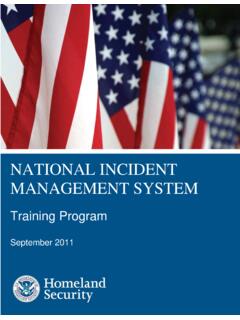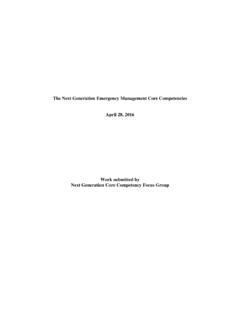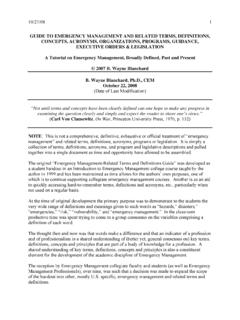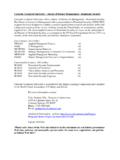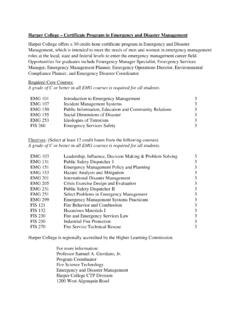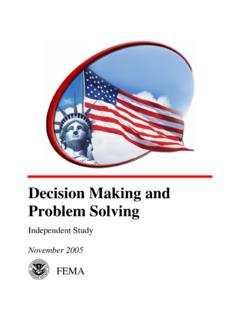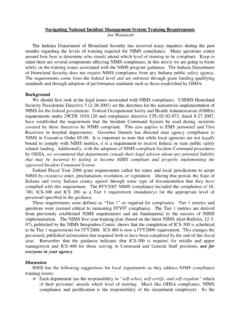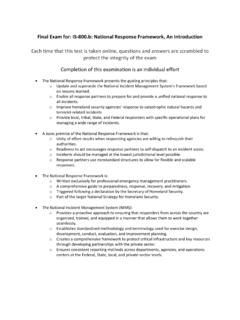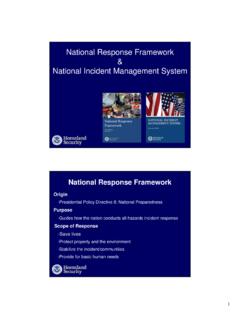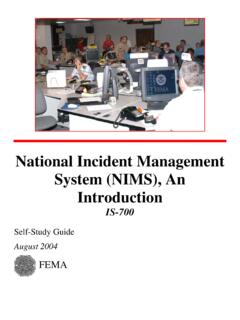Transcription of National Incident Management System (NIMS) …
1 FEMA Emergency Management InstituteNational Incident Management System ( nims ) 2017 Learning MaterialsSlide 1 nims 2017 Learning Materials Purpose In October 2017 FEMA published a revision of the National Incident Management System ( nims ). The 2017 nims document replaces the 2008 nims . This content is to provide information to emergency Management practitioners on the key changes contained in the new nims 2017 document. These learning materials are provided as a bridge to deliver interim nims 2017 document refresh information until updated nims courses are available. This is not intended as stand-alone training on nims . This content is designed as a supplement to be used in conjunction with existing legacy nims / ICS course materials in order to provide students with additional information on key nims 2017 changes.
2 Slide 2 nims 2017 Update Training TopicsoNIMS 2017 HistoryoNIMS 2017 OverviewoNIMS 2017 Changes nims Fundamentals and Concepts of nims Resource Management Command and Coordination Communications and Information ManagementoNIMS Course UpdatesoSources of Additional nims InformationSlide 3 nims 2017 Update History FEMA led, whole community effort to update nims Retains key concepts and principles from 2004 and 2008 nims Incorporates policy updates from lessons learned from exercises and real-world incidents and disasters National engagement to review the nims document produced thousands of comments from whole community stakeholders Input from local, state, tribal and Federal subject matter experts Comments were adjudicated by an interdisciplinary panel Approved changes were incorporated into nims published in 2017 Slide 4 nims 2017 Overview (1 of 2) nims 2017 strengthens guidance for effective Incident Management .
3 Reflects and incorporates policy updates from lessons learned from exercises and real-world incidents and disasters Clarifies the processes and terminology for qualifying, certifying, and credentialing Incident personnel, building a foundation for the development of a National qualification System Removes the Preparedness component of nims to avoid redundancy with the National Preparedness System and Goal Clarifies that nims is more than just Incident Command System (ICS), and that it applies to all Incident personnel, from the Incident command post to the National Response Coordination Center Demonstrates the applicability of nims to all five mission areas (Prevention, Protection, Mitigation, Response and Recovery) Adds guidance on the Intelligence and Investigations function Slide 5 nims 2017 Overview (2 of 2) Refines the model for the Operational Period Planning Cycle Provides expanded EOC guidance based on input from local, state, tribal and territorial EOC leaders Describes common functions and terminology for staff in Emergency Operations Centers (EOC)
4 , while remaining flexible to allow for differing missions, authorities, and resources of EOCs across the Nation Explains the relationship among Incident Command Structure (ICS), Emergency Operation Centers (EOCs), and senior leaders/ policy groups (Multiagency Coordination Group) Enhances guidance on information Management processesSlide 6 nims 2008-2017 ComparisonNIMS2008 Com-ponentContents1 Preparedness2 Communicationsand Information Management3 Resource Management4 Command and Management Incident Command System (ICS) Multiagency Coordination System (MACS) Public Information5 OngoingManagement and MaintenanceElements of both the structure and content of nims have been changed in the nims 2017 updateNIMS2017 Com-ponentContents1 Fundamentals and Concepts of NIMS2 Resource Management3 Command and Coordination Incident Command System (ICS) Emergency Operations Centers (EOC) Multiagency Coordination Group (MAC Group) Joint Information System (JIS)4 Communicationsand Information ManagementSlide 7 nims 2017 Component 1: Fundamentals and ConceptsComponent includes: High-level summary of nims Brief history of nims nims guiding principles.
5 Flexibility Standardization Unity of Effort (new nims Guiding Principle) Overview of the nims components2008 nims Flexibility Standardization2017 nims Flexibility Standardization Unity of EffortSlide 8 nims Guiding Principles Unity of Effort Flexibility and Standardization should be familiar to you from nims 2008. Unity of Effort is a third nims Guiding Principle added in nims 2017. Unity of effort means coordinating activities among various organizations to achieve common objectives. Unity of effort enables organizations with specific jurisdictional responsibilities to support each other while maintaining their own authorities. Slide 9 Overview of nims Components (1 of 2) nims 2008 defined five nims Components: Preparedness, Communications and Information Management , Resource Management , Command and Management , and Ongoing Management and 2017 defines three nims framework components which enable diverse organizations to integrate capabilities and achieve shared goals: Resource Management Command and Coordination Communications and Information ManagementSlide 10 Overview of nims Components (2 of 2)Definitions of the three nims framework components.
6 Resource Management describes standard mechanisms to systematically manage resources, including personnel, equipment, supplies, teams, and facilities, both before and during incidents in order to allow organizations to more effectively share resources when needed. Command and Coordination describes leadership roles, processes, and recommended organizational structures for Incident Management at the operational and Incident support levels and explains how these structures interact to manage incidents effectively and efficiently. Communications and Information Management describes systems and methods that help to ensure that Incident personnel and other decision makers have the means and information they need to make and communicate 11 nims 2017 Component 2.
7 Resource Management Reorganizes key resource Management activities to address resource planning (pre- Incident ) resource Management activities (during incidents), and mutual aid Establishes a foundation for a National qualification System by clarifying processes for qualifying, certifying and credentialing Incident personnel Emphasizes the role of the Authority Having Jurisdiction (AHJ)2008 nims Concepts and Principles Managing Resources2017 nims Resource Management Preparedness Resource Management During an Incident Mutual AidSlide 12 Resource TypingResource typing establishes common definitions for capabilities of personnel, equipment, teams, supplies, and facilities. Typing definitions include the following information: Capability: the core capability for which the resource is most useful Category: the function for which a resource would most likely be used such as firefighting, law enforcement, health and medical, etc.
8 Kind: a broad classification such as personnel, teams, facilities, equipment and supplies Type: a resource s level of minimum capability to perform its function; based on size, power, capacity (for equipment) or experience and qualifications (for personnel or teams)The Resource Typing Library Tool (RTLT) is an online catalog of nims resource typing definitions and job titles/position qualifications available through the FEMA website (link provided at the end of this presentation).Slide 13 CredentialingQualifying, certifying and credentialing are essential steps, led by an Authority Having Jurisdiction (AHJ) to help ensure that deploying emergency Management personnel can perform their assigned role. Qualification:personnel meet minimum established criteria -training, experience, physical and medical fitness, capability to fill specific positions Certification/Recertification: recognition from an AHJ or a third party stating that an individual is qualified for a specific position Credentialing.
9 Documentation from an AHJ or a third party, usually in the form of an identification card or badge, that identifies personnel and verifies their qualifications for a particular positionSlide 14 Authority Having Jurisdiction (AHJ) The AHJ is a public or private sector entity that has the legal authority to establish and administer processes to qualify, certify, and credential personnel for Incident -related positions. The AHJ may be a state or Federal agency, training commission, NGO, private sector company, or a tribal or local agency such as a police, fire, or public health department. The AHJ derives authority to credential from the elected official or, in the private sector, from the senior executive.
10 Slide 15 nims Qualification, Certification and Credentialing Process The nims qualification, certification and credentialing process supports sharing of personnel resources for mutual aid. Nationally standardized criteria and minimum qualifications for positions provide a consistent baseline for qualifying and credentialing the Incident workforce. This is a decentralized process that relies on Authorities Having Jurisdiction (AHJ). Each jurisdictional authority develops, implements, maintains, and oversees the qualification, certification, and credentialing process within its organization or 16 Resources - Preparedness Activities Before an Incident jurisdictions and organizations develop resource plans.
